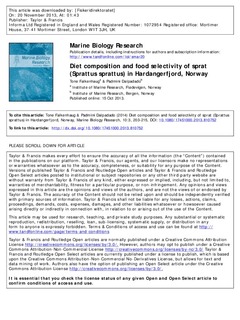| dc.contributor.author | Falkenhaug, Tone | |
| dc.contributor.author | Dalpadado, Padmini | |
| dc.date.accessioned | 2013-11-20T09:56:26Z | |
| dc.date.available | 2013-11-20T09:56:26Z | |
| dc.date.issued | 2013-10-15 | |
| dc.identifier.citation | Tone Falkenhaug & Padmini Dalpadado (2014) Diet composition and food selectivity of sprat (Sprattus sprattus) in Hardangerfjord, Norway, Marine Biology Research, 10:3, 203-215, DOI: 10.1080/17451000.2013.810752 | no_NO |
| dc.identifier.issn | 1745-1019 | |
| dc.identifier.issn | 1745-1000 | |
| dc.identifier.uri | http://hdl.handle.net/11250/109080 | |
| dc.description.abstract | The diet composition and prey selection of sprat (Sprattus sprattus) was studied in the Hardangerfjord, western Norway during four cruises in spring and autumn of 2009 and 2010. Feeding activity, indicated by stomach fullness, varied with sprat size, season and time of day. Small-sized sprat were found to feed both in spring and autumn, while the larger individuals had lower feeding activity late in the season. Diurnal variation in stomach fullness was observed in the autumn but not in spring. Sprat fed on a broad diversity of prey types, including copepods, phytoplankton and meroplankton.
Multivariate statistical analysis suggested that the dietary composition of sprat differed significantly between years, seasons and among areas within the fjord. During spring, phytoplankton and invertebrate eggs dominated the diet, while copepods were most important in the autumn. Positive selection was found for Microsetella norvegica and euphausiid eggs, which were the most frequently occurring prey in stomachs, followed by Oithona and Acartia spp. Interannual variability in zooplankton abundance in the fjord, related to physical processes, may have a large impact on the feeding conditions for fjord populations of sprat. | no_NO |
| dc.language.iso | eng | no_NO |
| dc.publisher | Taylor & Francis | no_NO |
| dc.title | Diet composition and food selectivity of sprat (Sprattus sprattus) in Hardangerfjord, Norway | no_NO |
| dc.type | Journal article | no_NO |
| dc.type | Peer reviewed | no_NO |
| dc.subject.nsi | VDP::Agriculture and fishery disciplines: 900::Fisheries science: 920::Fish health: 923 | no_NO |
| dc.source.pagenumber | 203-215 | no_NO |
| dc.source.volume | 10 | no_NO |
| dc.source.journal | Marine Biology Research | no_NO |
| dc.source.issue | 3 | no_NO |
| dc.identifier.doi | 10.1080/17451000.2013.810752 | |
| dc.relation.project | NRC 188955/130 | no_NO |
